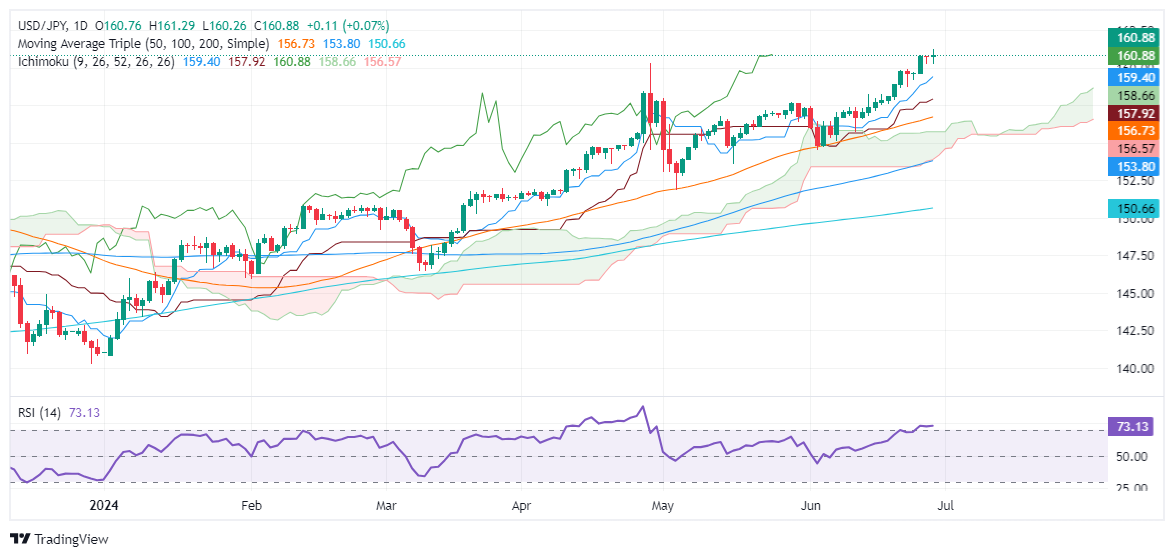- Analytics
- News and Tools
- Market News
- USD/JPY Price Analysis: Extends gains near 161.00
USD/JPY Price Analysis: Extends gains near 161.00
- USD/JPY climbs to 160.89, up 0.08%, buoyed by strong US data and rising Treasury yields.
- Technicals show buyer momentum; RSI overbought but not extreme.
- Resistance levels: 161.00, 162.00, 164.87 (Nov 1986 high), 178 (Apr 1986 high).
- Support found at 159.19 (Tenkan-Sen), 158.75 (June 24 low), 158.65 (Senkou Span A), 157.91 (Kijun-Sen).
The USD/JPY extended its gains on Friday and is set to end the week with more than 0.50% gains after US economic data spurred a jump in the US Treasury, despite increasing speculations that the US central bank could cut rates in 2024. The USD/JPY trades at 160.89, up 0.08%.
USD/JPY Price Analysis: Technical analysis
The USD/JPY uptrend remains intact, though traders are cautious after reclaiming the psychological 160.00 level, which is viewed as the first line of defense for Japanese authorities to intervene in the FX markets. Despite this, the pair has continued to advance steadily, increasing intervention risks.
Momentum favors buyers, even though the Relative Strength Index (RSI) is overbought. However, due to the strength of the uptrend, many technicians consider 80 as the threshold for "extreme" overextended conditions.
The USD/JPY first resistance levels would be the psychological marks of 161.00, 162.00, and so forth, leading up to the November 1986 high of 164.87. Beyond that, the next significant resistance is the April 1986 high of 178.
Conversely, if USD/JPY drops below 160.00, the first support would be the Tenkan-Sen at 159.19, followed by the June 24 low of 158.75. Once those levels are cleared, the next support is the Senkou Span A at 158.65, followed by the Kijun-Sen at 157.91.
USD/JPY Price Action – Daily Chart
Japanese Yen FAQs
The Japanese Yen (JPY) is one of the world’s most traded currencies. Its value is broadly determined by the performance of the Japanese economy, but more specifically by the Bank of Japan’s policy, the differential between Japanese and US bond yields, or risk sentiment among traders, among other factors.
One of the Bank of Japan’s mandates is currency control, so its moves are key for the Yen. The BoJ has directly intervened in currency markets sometimes, generally to lower the value of the Yen, although it refrains from doing it often due to political concerns of its main trading partners. The current BoJ ultra-loose monetary policy, based on massive stimulus to the economy, has caused the Yen to depreciate against its main currency peers. This process has exacerbated more recently due to an increasing policy divergence between the Bank of Japan and other main central banks, which have opted to increase interest rates sharply to fight decades-high levels of inflation.
The BoJ’s stance of sticking to ultra-loose monetary policy has led to a widening policy divergence with other central banks, particularly with the US Federal Reserve. This supports a widening of the differential between the 10-year US and Japanese bonds, which favors the US Dollar against the Japanese Yen.
The Japanese Yen is often seen as a safe-haven investment. This means that in times of market stress, investors are more likely to put their money in the Japanese currency due to its supposed reliability and stability. Turbulent times are likely to strengthen the Yen’s value against other currencies seen as more risky to invest in.
© 2000-2024. All rights reserved.
This site is managed by Teletrade D.J. LLC 2351 LLC 2022 (Euro House, Richmond Hill Road, Kingstown, VC0100, St. Vincent and the Grenadines).
The information on this website is for informational purposes only and does not constitute any investment advice.
The company does not serve or provide services to customers who are residents of the US, Canada, Iran, The Democratic People's Republic of Korea, Yemen and FATF blacklisted countries.
Making transactions on financial markets with marginal financial instruments opens up wide possibilities and allows investors who are willing to take risks to earn high profits, carrying a potentially high risk of losses at the same time. Therefore you should responsibly approach the issue of choosing the appropriate investment strategy, taking the available resources into account, before starting trading.
Use of the information: full or partial use of materials from this website must always be referenced to TeleTrade as the source of information. Use of the materials on the Internet must be accompanied by a hyperlink to teletrade.org. Automatic import of materials and information from this website is prohibited.
Please contact our PR department if you have any questions or need assistance at pr@teletrade.global.
















